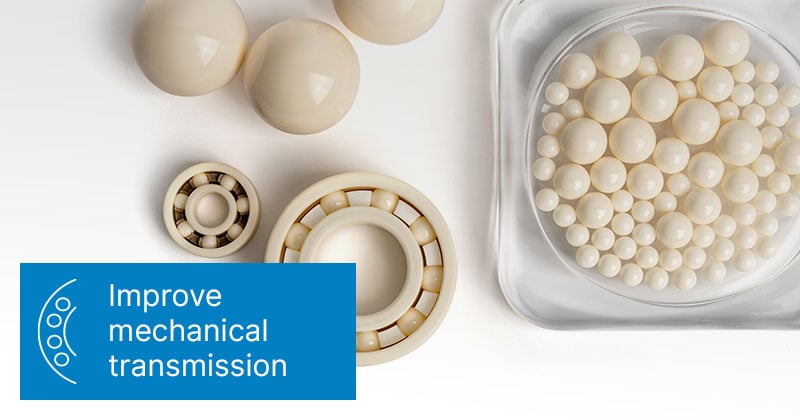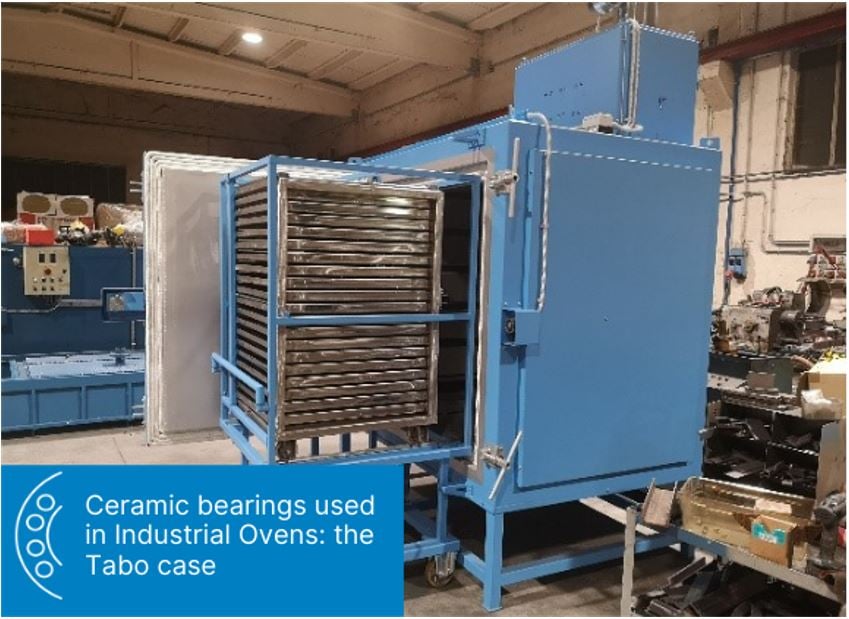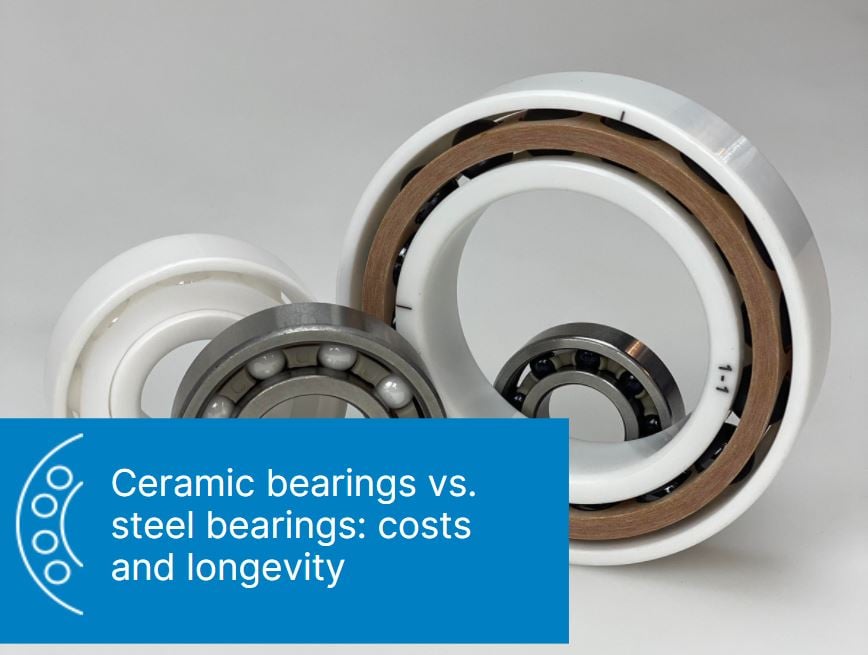
In some applications it is important to try to maximize the performance of mechanical transmissions. An important source of energy dispersion is represented by the bearings due to the friction inside them. Trying, therefore, to reduce friction to the minimum possible is one of the priorities in these contexts.
In this article we will analyze the 6 causes of friction inside a bearing, what to do to reduce them and we will present an innovative solution that allows to overcome very effectively the limits of steel bearings and to obtain a minimum level of energy dispersion unthinkable for the standard bearings: fully ceramic bearings.
Rolling bearings are mechanical components that are intended to guide and support a rotary movement. In carrying out this function, however, part of the energy necessary to maintain the rotary motion, however small, is dissipated due to the friction that is created in the bearing. With a view to increasing the efficiency of the transmission it is necessary to reduce the internal friction of the bearing as much as possible.
Main causes of friction
First of all, let's try to understand what are the causes of this friction, i.e. where it is possible to act to reduce the energy dissipated by the bearing.
The main causes of friction in a bearing, in order of importance and influence, are:
- Lubrication characteristics: type and quantity of lubricant
- Friction caused by the seals
- Bearing clearance
- Bearing accuracy class
- Roughness of raceways and rolling elements
- Hardness of raceways and rolling elements
Let's analyze them in detail:
-
Lubrication
The purpose of the lubrication is to create a film between the rolling element and the raceway that avoids direct contact and allows the dissipation of the heat created in the contact surface. For these actions to take place it is necessary that the lubricant
has an adequate viscosity in order to withstand the load acting on the bearing and that this is maintained in the temperature range of use of the bearing. A too high viscosity, however, if on the one hand it can be a safety in terms of load resistance, on the other it can represent an obstacle to the movement of the rolling element by increasing the friction of the bearing and, therefore, the dissipated energy.
Similarly, the amount of lubricant inserted into the bearing can play an important role. In fact, even if the viscosity of the lubricant is adequate for the load conditions of the bearing, a too low quantity does not allow to create the right film thickness. At the same time, however, if the quantity of lubricant is too high, an obstacle to rolling is created with an increase in friction and dissipated energy.
Therefore, in order to minimize friction, it is necessary:
- carefully choose the degree of viscosity of the lubricant which depends on the load acting on the bearing, the rotation speed and the working temperature: if the viscosity is too low, an adequate lubricating film is not formed between the rolling element and the race, if it is too high considerably increases friction
- choose the quantity of lubricant to insert into the bearing; here too, too little prevents the formation of an adequate lubricating film and too much will increase friction.
It should be considered that the use of special lubricants or the variation in the quantity of lubricant normally inserted inside the bearings causes the bearing to become "special" with a consequent possible increase in costs and supply difficulties.
-
seals
The seals that are used in the bearings have two basic purposes: to keep the lubricant inside the bearing and protect the bearing from the entry of foreign materials that could affect the functionality not only of the bearing but also of the lubricant. From the point of view of friction, the seals that contribute to increasing it are the sliding type, ie the RS, as they have a sealing lip that crawls on the bearing ring.
In order to minimize friction, it must be carefully evaluated whether it is necessary to use RS type seals or whether non-sliding (Z) can be used. It is also possible to take particular care of the contact surface between the bearing ring and the gasket in order to reduce friction. This solution, however, may not be the standard supply of bearings and, therefore, represent an increase in costs and an increase in the difficulty of supply.
-
bearing clearance
The reduction of the bearing play increases the number of rolling elements in contact with the raceway, increasing friction and energy dissipation.
In order to reduce friction, therefore, the widest possible clearance must be chosen, compatibly with the conditions of use of the bearing.
-
bearing accuracy class
In the realization of the bearing rings, errors of form are introduced which deviate the surfaces of the raceways from the theoretical one. These deviations produce irregular contacts with the rolling elements causing an increase in friction in the rolling of the bearing.
To reduce friction it would be necessary to choose bearings with the highest possible precision. However, these bearings can have high costs and supply difficulties. Since the weight of accuracy on the total friction calculation is low, it may not be necessary to use non-standard accuracy classes.
-
Roughness of raceways and rolling elements
Since there is also a sliding component in the rolling of the rolling elements of the bearing on the raceways, the roughness of the two surfaces plays an important role. In fact, the greater the roughness, the greater the friction.
It is difficult to intervene on this parameter, in the sense that it is not possible to ask the bearing manufacturers to adopt a roughness value different from the standard unless one accepts that the bearing becomes a "special" one. It is possible to use super-precise bearings which, however, add a high accuracy class to a lower raceway roughness than normal bearings. They are high-cost bearings and are not found in all forms of construction.
-
Hardness of raceways and rolling elements
The sliding component mentioned in the previous point depends on the extension of the contact surface between the rolling element and the track. The larger the surface, the greater the sliding. The size of the contact surface depends on the hardness of the material from which the rings and rolling elements are made
bearings. The harder the material and the smaller the surface and the less friction will be.
Again, this parameter is not “adjustable”. The degree of hardness of the raceways and rolling elements depends on the hardening process to which the steels are subjected.
Choosing the characteristics of a bearing to minimize energy dissipation requires evaluating the points mentioned above and it is not always easy or possible to find the solution.
Full ceramic bearings: characteristics
Today, however, there is an innovative solution that provides an answer to the search for the lowest friction: fully ceramic bearings.
Let's see what are the characteristics of these bearings in relation to the points indicated above and the reasons why they can be the optimal solution:
-
Lubrication
The ceramic materials used for the construction of these bearings (Zirconium Oxide ZrO2 and Silicon Nitride Si3N4) do not require careful lubrication (both in terms of type of lubricant and quantity) as, however, happens for steel bearings. . In fact, fully ceramic bearings can also operate in the absence of lubrication. With this type of bearings, therefore, it is possible to use, if necessary, a minimum amount of lubricant keeping the friction at very low values.
-
Seals
Since fully ceramic bearings can operate even without lubrication, they do not need to be protected with sliding type seals. This allows to significantly reduce friction.
-
Bearing clearance
In the case of bearing play, the same considerations as in point 3 above apply.
-
Bearing precision class
Also with regard to the precision class of the bearing, the same considerations apply to fully ceramic bearings as for steel bearings.
-
Roughness of raceways and rolling elements
Thanks to the characteristics of ceramic materials, the roughness obtainable on raceways and rolling elements is generally lower than that found in steel bearings. This implies that there is a reduction of friction. -
Hardness of raceways and rolling elements
Ceramic materials are much harder than hardened bearing steel. It follows that the contact surface between the rolling element and the raceway is smaller and, therefore, also the sliding and therefore the friction.
In conclusion, totally ceramic bearings, thanks to their characteristics, can be the optimal solution for all those conditions in which it is absolutely necessary to minimize the dissipation of energy and therefore increase the efficiency of the mechanical transmission.Find the best bearings for your application: get in touch with our experts.








